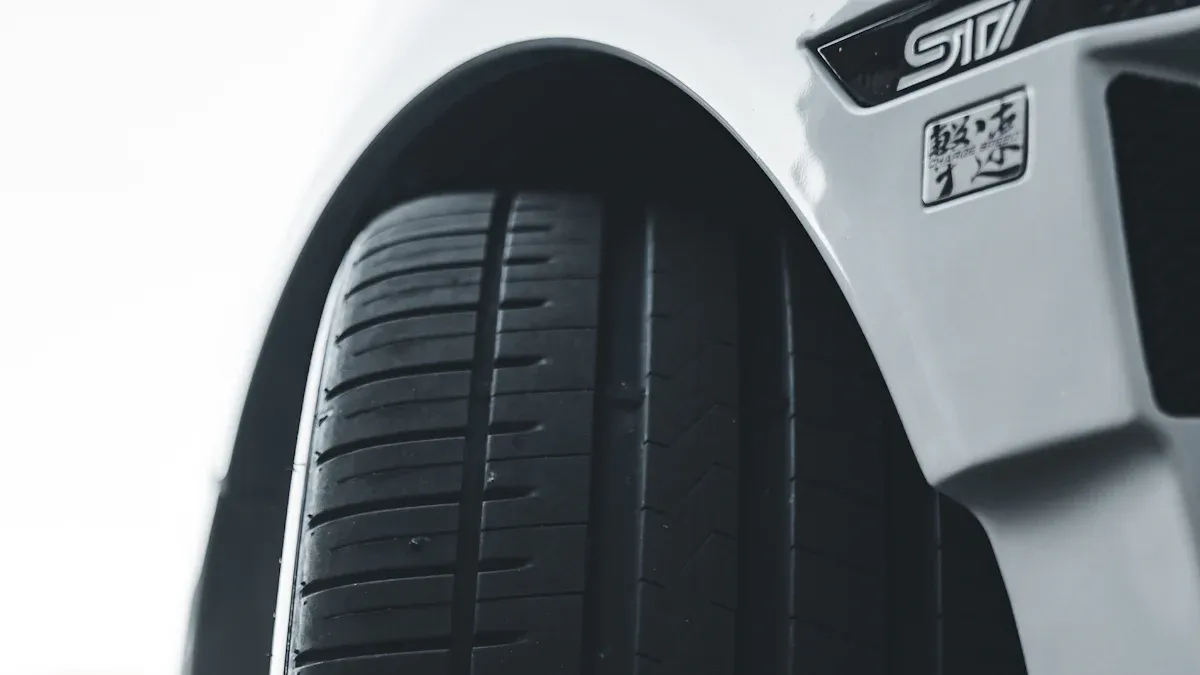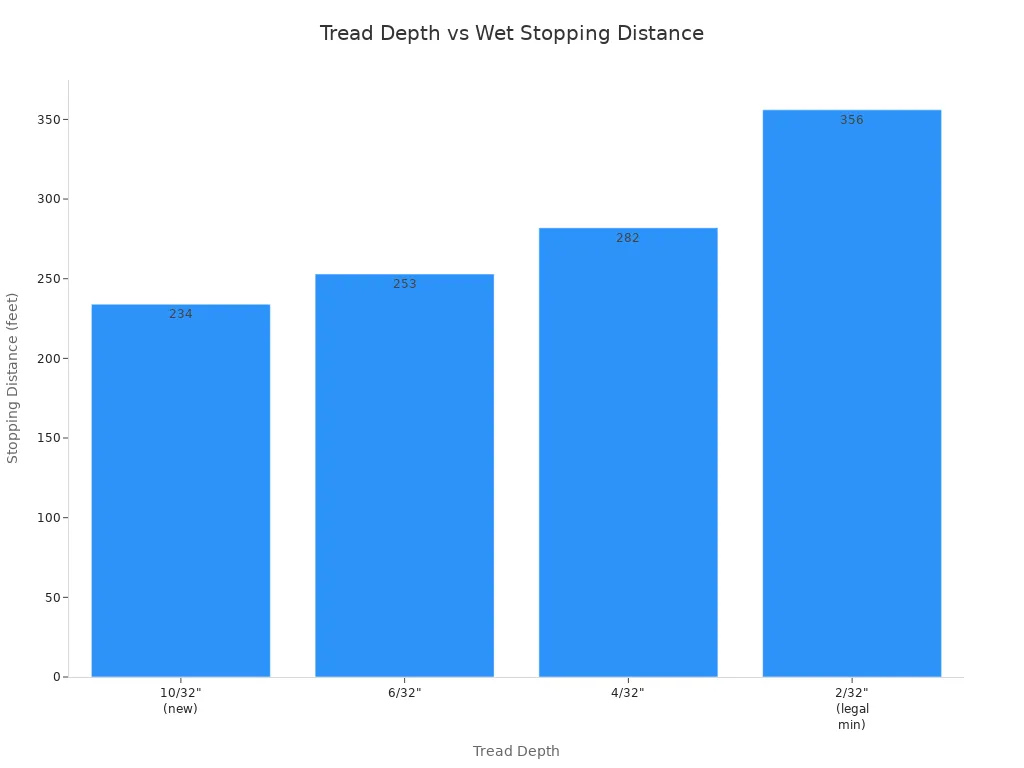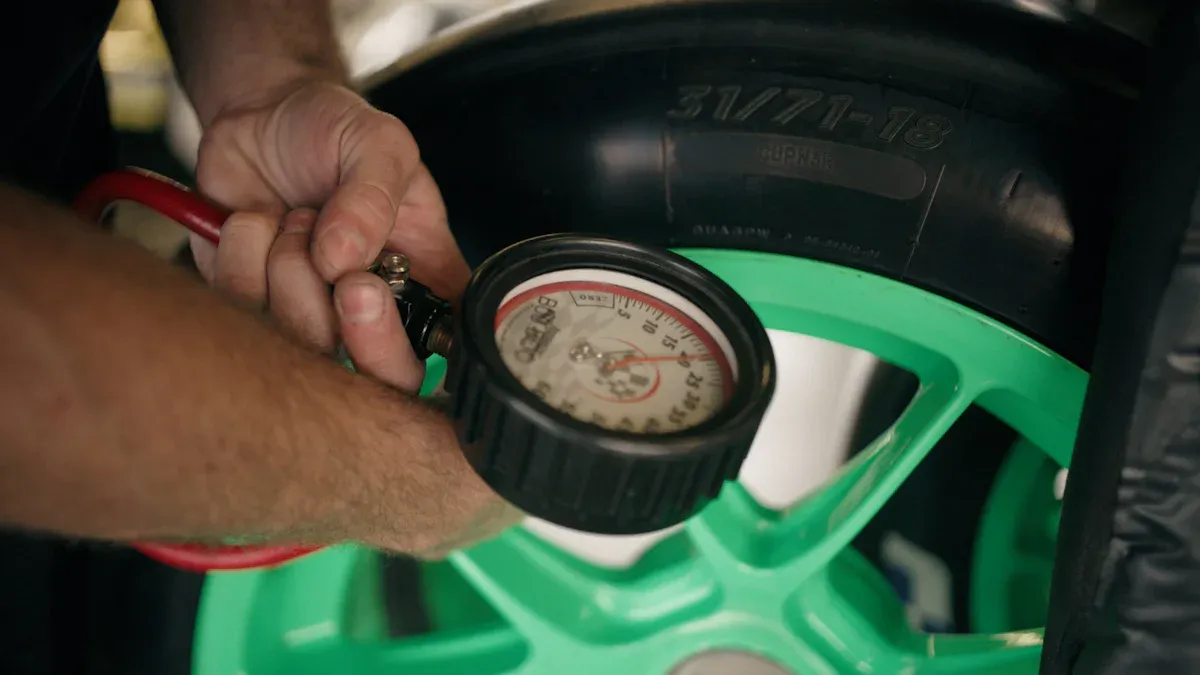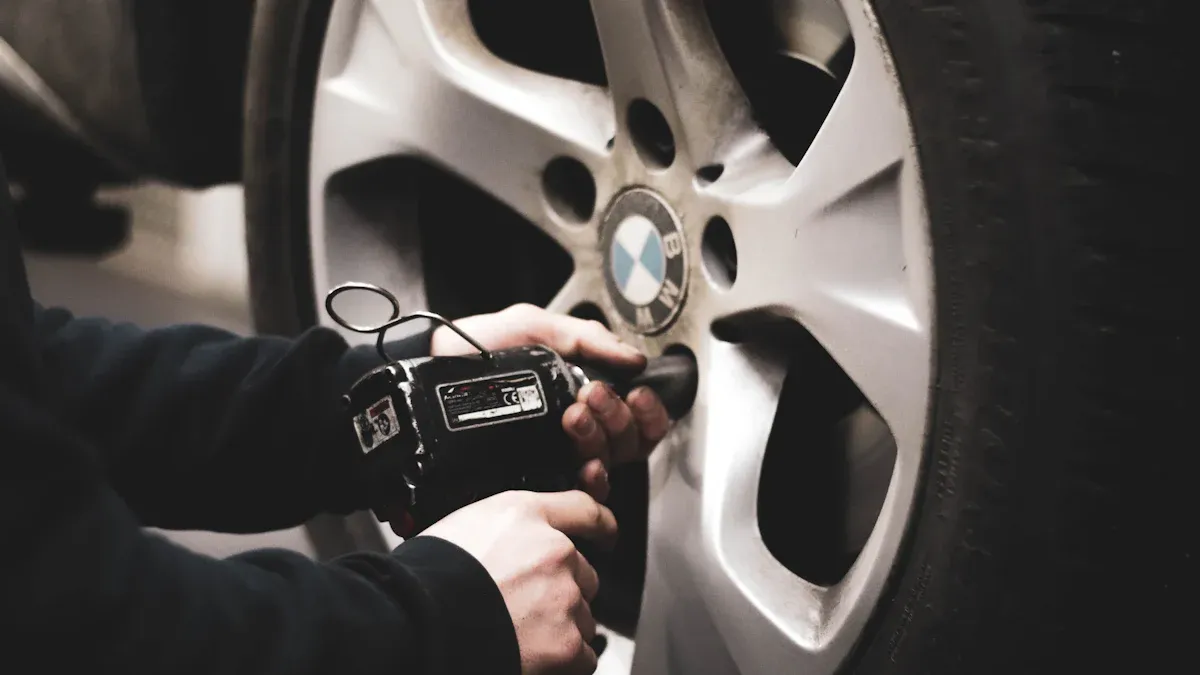
Measuring tire tread depth is crucial for your safety and vehicle performance, but you might wonder how is tire tread measured effectively. Adequate tread depth ensures your tires grip the road well, especially in wet conditions. Driving on worn tires can lead to longer stopping distances, increasing the risk of accidents. For example, recent studies show that stopping distances can increase by up to 52% as tread depth decreases.
To understand how is tire tread measured, you can use various methods such as tread depth gauges, visual inspections, and simple tests like the penny test. Regularly checking your tread depth will help you maintain optimal tire performance and safety.

Punti chiave
Regularly measure your tire tread depth to keep your vehicle safe and performing well.
Use tools like tread depth gauges or simple tests like the penny test to check your tires easily.
Replace tires before the tread wears down to 4/32 inches to stay safer than the legal minimum.
Follow state laws on minimum tread depth and avoid driving on tires that are too worn.
Maintain your tires by checking pressure, rotating them, and inspecting for damage often.
How is Tire Tread Measured with a Gauge

Selecting the Right Gauge
When you decide to measure tire tread depth, choosing the right gauge is essential for accuracy. Several types of tire tread depth gauges are available on the market, each with its own advantages. Here are the most common options:
Digital Tire Tread Depth Gauges: These provide precise readings and often feature easy-to-read displays.
Manual Tire Tread Depth Gauges: These are simple and cost-effective, making them a popular choice for home use.
Mechanical Tire Tread Depth Gauges: These offer reliable measurements without the need for batteries.
Laser Tire Tread Depth Gauges: These advanced tools use laser technology for highly accurate measurements.
When selecting a gauge, consider the following features:
Choose between digital or analog readouts based on your preference; both are effective.
Consider portability: some gauges fit easily in a shirt pocket, while others are bulkier.
Cost ranges from about $2 to $20; affordable options are available for both home and professional use.
Look for color-coded displays (green, yellow, red) to help interpret tread wear quickly, especially in poor lighting.
Multi-function gauges (e.g., combined tire pressure and tread depth) offer convenience but may sacrifice some durability or precision.
Regular use and human interpretation remain important; gauges assist but do not replace visual inspection.
Step-by-Step Measurement Process
Using a tire tread depth gauge is straightforward. Follow these steps to ensure accurate measurements:
Calibrate the Gauge: Push the tread depth gauge against a flat surface, fully inserting the measuring pin into the barrel until it reads zero. This ensures it is calibrated.
Position the Gauge: Place the gauge in the center of the tire’s tread groove. Ensure the probe is fully seated in the tread groove.
Press Down: Firmly press the gauge against the tire until its base touches the tire surface. This action provides an accurate reading.
Leggi la misurazione: Check the display on the gauge, which may show measurements in millimeters or inches. A safe tread depth is around 4/32 of an inch.
Check Multiple Points: Measure at several points around the tire to account for uneven wear. This step is crucial for understanding the overall condition of your tires.
Calculate the Average: If you take multiple readings, calculate the average to get a more accurate tread depth. Compare this average to the tire’s original specifications to determine the remaining tire wear.
By following these steps, you can accurately measure tire tread depth and ensure your tires remain safe and effective on the road. Remember, regular checks are vital for maintaining optimal tire performance and safety.
Visual Methods for Measuring Tread Depth

Measuring tire tread depth visually can be simple and effective. You can use two common methods: checking wear bars and performing the penny test. Both methods provide quick insights into your tire’s condition.
Using Wear Bars
Wear bars, also known as tread wear indicator bars, are small raised sections located within the grooves of your tires. These bars serve as a visual cue for when your tires need replacement. Here’s how to use them:
Locate the Wear Bars: Inspect the grooves of your tire. You will find small raised bars that run perpendicular to the tread.
Compare Tread Height: When the tread surface wears down to the level of these wear bars, it indicates that the tread depth has reached 2/32 di pollice, which is the minimum legal tread depth in most states.
Feel for Wear: You can also run your finger over the tread ribs and wear bars. If they feel even, your tires are worn out and need replacement.
When your tire tread ribs are visibly higher than the wear bars, your tires have adequate tread. However, if the tread ribs are flush with the wear bars, it’s time to consider replacing your tires. Manufacturers often recommend replacing tires before reaching this minimum depth for enhanced safety.
Il test della moneta
The penny test is another quick and easy method to check your tire tread depth. Here’s how to perform it:
Get a Penny: Use a standard U.S. penny featuring Abraham Lincoln.
Insert the Penny: Place the penny into a tread groove with Lincoln’s head facing downward.
: Inserisci la moneta nelle scanalature del battistrada della gomma. Assicurati che la testa di Lincoln sia rivolta verso il basso.: If you can see the top of Lincoln’s head, your tread depth is less than 2/32 of an inch. This indicates that your tires are worn and should be replaced for safety.
Repeat the Test: Perform the test in several locations on each tire to check for uneven wear.
While the penny test is a popular method, it only signals the absolute minimum legal tread depth. For a more conservative measure, consider using the quarter test, which assesses tread depth against a safer threshold of 4/32 di pollice. If you can see all of Washington’s head on a quarter, your tires need replacement. This method provides a more reliable assessment of when to replace tires before they become dangerously worn.
By using these visual methods, you can easily monitor your tire tread depth and ensure your safety on the road. Regular checks will help you maintain optimal tire performance and avoid potential hazards.
Understanding Legal Minimum Tread Depths
State Regulations
Understanding state regulations regarding tire tread depth is essential for every driver. Most states in the U.S. set a legal minimum tread depth of 2/32 pollici for passenger vehicles. However, some states, like Idaho and California, have stricter requirements of 1/32 inch. A few states do not specify any minimum tread depth, which can lead to confusion. Here’s a quick overview of the legal minimums:
Category | Legal Minimum Tread Depth (inches) | Note |
|---|---|---|
Majority of U.S. States (42) | 2/32 | Standard minimum for passenger vehicles |
Idaho and California | 1/32 | Exceptions with lower minimum tread depth |
States with No Specific Standard | N/A | West Virginia, South Carolina, North Dakota, New Mexico, Montana, Arkansas |
Winter Tires (some states) | 4/32 or 5/32 | Higher minimum tread depth required for winter tire classification |
Implicazioni sulla sicurezza
Driving on tires with insufficient tread depth poses serious safety risks. Worn tires struggle to channel water away from the contact patch, increasing the likelihood of hydroplaning. Studies show that tires with tread depths below 2/32 pollici have a significantly higher risk of losing traction in wet conditions. Here are some critical points to consider:
Increased Stopping Distances: Worn tires can increase stopping distances by up to 33% for passenger cars. This delay can be dangerous in emergency situations.
Rischio di aquaplaning: Tires with shallow tread depth cannot effectively disperse water, leading to a higher chance of hydroplaning. This phenomenon can occur at speeds as low as 35 mph when the tread depth is inadequate.
Legal Consequences: Driving on tires that do not meet legal minimums can result in fines during roadside inspections. Tire tread depth less than 2/32 di pollice is a common violation, indicating the importance of regular checks.
Maintaining proper tread depth is crucial for safe driving. Regularly checking your tires can help you avoid accidents and ensure compliance with state regulations. Remember, replacing tires before they reach the legal minimum can enhance your safety on the road.
Tips for Regular Tire Maintenance
When to Check Tread Depth
Regularly checking your tire tread depth is essential for safe driving. You should inspect your tires at least once a month and before embarking on long trips. Here are some key points to remember:
Monthly Checks: Make it a habit to check your tread depth every month. This routine helps you catch any issues early.
Before Long Trips: Always check your tires before taking long journeys. This precaution ensures your tires are in good condition for the road ahead.
Use Simple Tests: Employ methods like the penny test or a tread depth gauge to assess your tires. These tools help you determine if your tread depth is adequate.
Replace Tires Early: Consider replacing your tires when tread depth reaches 4/32 inches. This recommendation is safer than waiting for the legal minimum of 2/32 inches.
Regular inspections help prevent hydroplaning and maintain vehicle control, especially in wet conditions.
Other Tire Care Practices
In addition to checking tread depth, you should adopt other tire care practices to extend the life of your tires. Here are some effective tips:
Maintain Proper Inflation: Ensure your tires are inflated to the manufacturer’s recommended pressure. Underinflated tires wear unevenly and can reduce tread life by up to 50%.
Rotate Tires Regularly: Rotate your tires every 5,000 to 8,000 miles. This practice promotes even wear and improves vehicle handling.
Ispeziona per danni: Regularly look for signs of wear, such as cracks or bulges. Early detection can prevent further damage and costly replacements.
Monitor Alignment and Balance: Have your wheel alignment checked if you notice your vehicle pulling to one side. Misalignment can lead to uneven tread wear.
Address Unusual Symptoms: Pay attention to any vibrations or noises while driving. These could indicate tire or alignment issues that need immediate attention.
By following these maintenance tips, you can enhance your tire performance and safety on the road. Regular checks and proper care will help you avoid dangerous driving situations and extend the lifespan of your tires.
In summary, measuring tire tread depth is vital for your safety and vehicle performance. You can use various methods, such as tread depth gauges and visual tests like the test della moneta, to assess your tires. Regular checks help you avoid dangerous situations caused by worn tires.
Remember, maintaining proper tread depth can significantly reduce the risk of tire blowouts, which account for a substantial percentage of vehicle defects linked to crashes.
Establishing a routine for tire maintenance, including checking tread depth, can enhance your safety on the road. Make it a habit to inspect your tires regularly and ensure they remain in optimal condition. Your safety depends on it! 🚗✨
FAQ
Qual è la profondità ideale del battistrada per la sicurezza?
The ideal tire tread depth for safety is at least 4/32 inches. This depth helps maintain traction, especially in wet conditions. Regularly check your tires to ensure they meet this standard.
Quanto spesso devo controllare la profondità del battistrada delle mie gomme?
You should check your tire tread depth at least once a month. Additionally, inspect your tires before long trips to ensure they are safe and in good condition.
Posso usare un righello per misurare la profondità del battistrada?
Yes, you can use a ruler to measure tread depth. Insert the ruler into the tread groove and measure from the bottom of the groove to the top of the tread. Ensure you check multiple spots for accuracy.
What happens if my tires are worn below the legal limit?
If your tires are worn below the legal limit of 2/32 pollici, you risk losing traction and increasing stopping distances. This condition can lead to dangerous driving situations, especially in wet weather.
Come posso prolungare la vita dei miei pneumatici?
To extend the life of your tires, maintain proper inflation, rotate them regularly, and check for alignment issues. Regular maintenance helps prevent uneven wear and prolongs tire lifespan.
Vedi anche
Step By Step Guide To Measuring Tire Tread Depth
Understanding Smart Tire Tread Detectors And Their Function
L'importanza dei controlli regolari del battistrada dei pneumatici per la sicurezza






